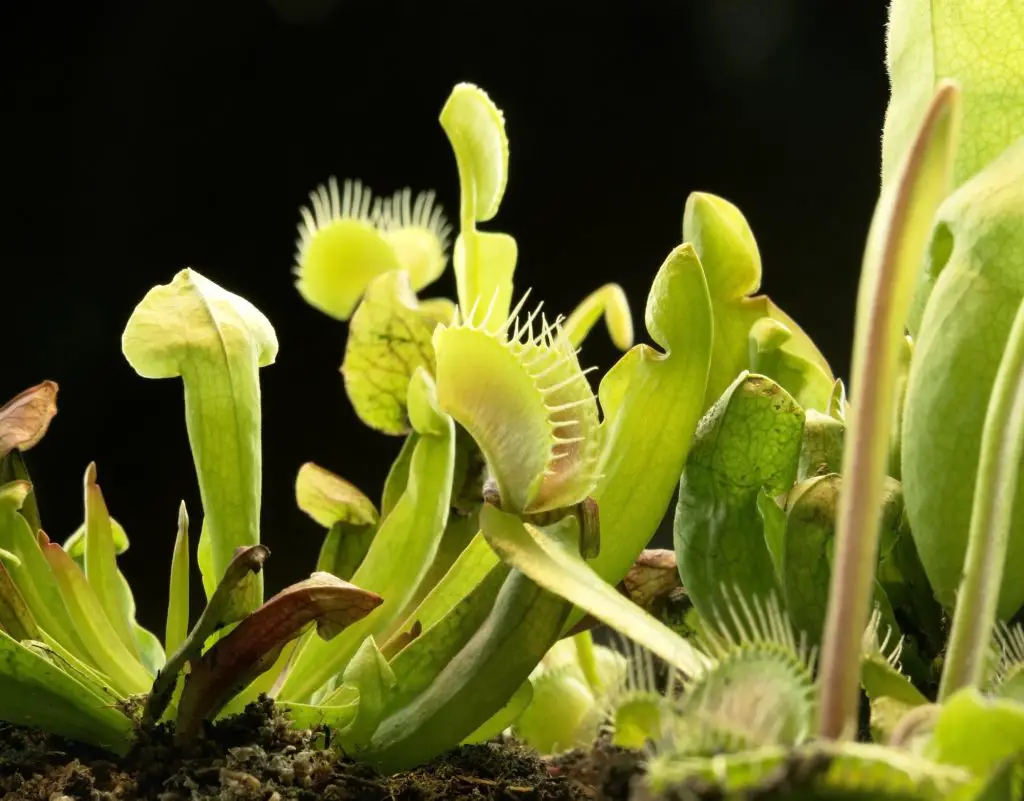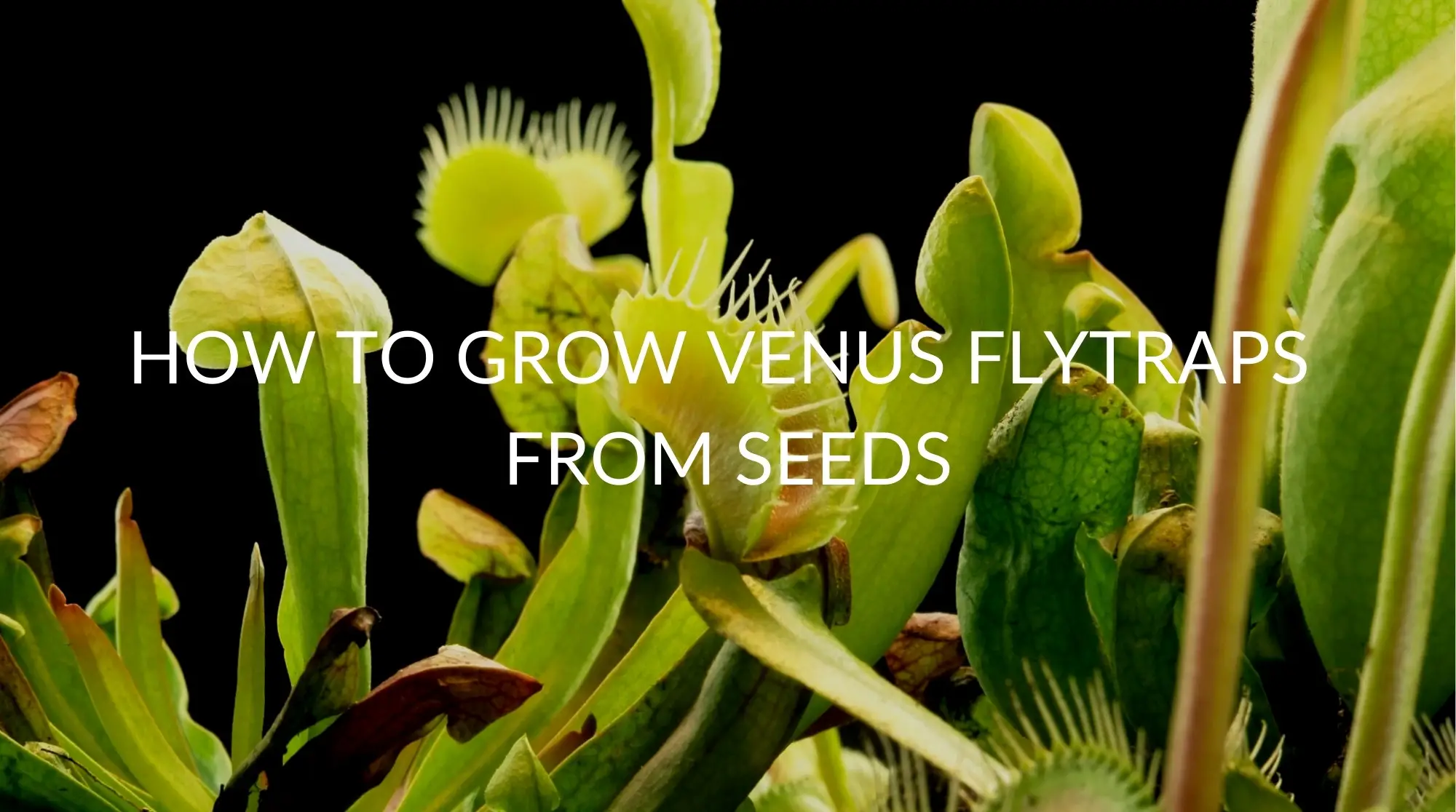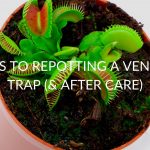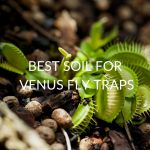Venus Flytraps can be grown through flower propagation, root dividing, and, more satisfyingly, by seed. When growing a Venus flytrap from seeds, you must use the correct type of soil and control variables such as light, humidity, and temperature. Unlike other plant species, Venus Flytrap seeds will not germinate if they are buried. Instead, Venus Flytrap seeds should be placed on the top of the soil and lightly covered with a substance like a sphagnum peat moss dust.
The following article details the steps needed to grow Venus Flytraps from seeds, including soil, water, humidity, and light requirements, along with interesting facts about Venus Flytrap germination, so read on to find out more!
How Long Do Venus Flytraps Take to Grow from Seed?
It only takes a short time for a Venus Flytrap seed to germinate. With the correct environment, your Venus Flytrap seeds should start germinating within 10 to 15 days. A lack of moisture in the air or soil or a low temperature can delay germination, causing the Venus Flytrap to take over 30 days to germinate. If conditions are not correct, Venus Flytraps will not germinate.
Although germination of young, tiny Venus Flytraps does not take long, you will not have a mature plant until 2 to 4 years later. Once the Venus Flytrap matures, it will be around 3 – 6 inches tall with a 5-inch diameter. When the Venus Flytrap reaches maturity, you will be able to pollinate its flowers to harvest your own seeds.
Is It Hard to Grow Venus Flytraps from Seeds?
Venus Flytraps are easy to grow from seed! Venus Flytraps are hardy species and tend to be easy to germinate. If the soil moisture, temperature, and humidity conditions for germination are correct, then Venus Flytrap taproots will easily pop through the seed shell within two weeks.
If you do not have the correct soil type or growing conditions, then it is very difficult to encourage a Venus Flytrap seed to germinate. These seeds have evolved to germinate quickly and directly on the ground after the fall off the mother plant, meaning Venus Flytrap seeds will have difficulty germinating if they become covered with too much soil or growing medium.
How To Grow Venus FlyTraps from Seeds
Acquire seeds
The first thing that you must do is acquire the Venus Flytrap seeds. They are not going to be found at just any store, so you will need to find a local specialty greenhouse or online store to buy Venus Flytrap seeds. Make sure the grower is reputable so that the seeds are less likely to come contaminated with mold, algae, or pesticides.
Use the proper soil type
Using the proper soil mix is one of the most important parts of growing Venus Flytraps from seed. These species need specific soil moisture content, which is achieved using materials such as peat moss. Make sure not to use mixes with soil amendments.
Maintain proper growing conditions
Not only does the soil moisture have to be right for germination to quickly be achieved, but the temperature of the soil and air, the humidity, and the light sources all play a huge role in determining the success of germination. Achieving success in growing a Venus Flytrap means controlling all these variables.
Have Patience
Even in ideal growing conditions, it is going to take time to grow a mature Venus Flytrap from seed. Be patient and allow the satisfaction of slowly growing a plant completely from seed to encourage you as this amazing species transform in front of your eyes.
Change growing conditions
Once your Venus Flytrap seeds have germinated, allow the plants to continue growing in their moist and covered environment for 4 – 6 weeks. At this point, you will want to start changing the environment by introducing more air and less moisture. Do this by taking the lid off the container each day and leaving it off for longer each day until the young Venus Flytrap has adjusted to its new environment.
Transplant
Once your young Venus Flytrap has grown accustomed to the environment outside of its germination container, then it is time to transplant into a more permanent home. This must be done very gently, and you can use the same soil mixture that you used for the seed starting.
Maintenance
Maintain a Venus Flytrap by watering it every 2 – 4 days, allowing the soil to remain moist but never flooded. Keep out of prolonged direct sunlight and never add fertilizers to your Venus Flytrap.

How To Germinate Venus Flytrap Seeds
Prepare Your Soil
Use a 1:1 ratio of peat moss and silica sand. Small-grained perlite can be added to this mix but is not necessary. You can also use a 1:1 mix of peat moss and perlite, but it is important to make sure that your ratios are correct. Sterilizing your soil is recommended to prevent algae and mold growth during the germination process.
Moisten Soil and Prepare Container
Spray your soil with fresh distilled water before placing the soil into the container to ensure even moisture through the entire thing. Fill your container with moistened soil and leave it in a warm environment for at least 12 hours.
Place Seeds
After the soil has had a chance to warm up, gently place the Venus Flytrap seeds on top of the prepared soil. Do not cover the seeds with soil.
Dust with Peat Moss
Directly after planting the Venus Flytrap seeds, sprinkle a small amount of peat moss dust on top of the entire container. This will help the seed and emerging root from drying out. If should still be able to see the seeds after dusting. If your seeds are not visible, then there is a chance that they will not germinate.
Moisten Soil and Seeds
Lightly spray distilled water on the dusted seeds and cover with a ventilated top. Keep the growing container at a higher humidity by spraying the soil and edges of the container and lid when needed. Even if moist enough, lift the lid at least once a day to replenish the container with fresh air.
Place in Light Source
Indirect bright light is the best for seed germination, and they will need more direct light once they mature. Do not place them where they will get prolonged direct sunlight because that could cause too much drying to occur.
Maintain Growing Conditions Until Germination Occurs
You should start to see results within 10 – 15 days. During the first 30 – 35 days, keep the soil moist and warm. Then gradually introduce more air and less water as the Venus Flytrap matures.
Planting Medium Requirements
Venus Flytraps need aerated soil that is well-draining while still able to hold moisture. Use a 1:1 ratio of peat moss and silica sand or perlite. If you need increased airflow within the soil, then additional small-grained perlite can help remedy that.
Venus Flytraps prefer acidic soil, which can be facilitated by the sphagnum peat moss. But perlite can be on the neutral side, so make sure not to use too much.
You cannot use soil with other ingredients such as added nutrients or fertilizers because this could contain things that would kill your Venus Flytrap. Many soil mixes are too “hot” for Venus Flytraps. This list of soils not to use includes potting soils, seed starters, or topsoil. You can alternatively use a premixed bag of soil designed for succulents.
Light Requirements
Venus Flytrap responds best to indirect light. If exposed to direct sunlight for prolonged periods of time, Venus Flytraps can become sunburned and possibly die. If placing the Venus Flytrap in a window, one facing east or west would be preferable due to the decreased harshness of morning or evening sun.
Once your Venus Flytrap is mature, you should provide it with 4 – 6 hours of sun per day. In the winter or during germination, you may use artificial grow lights. Be sure to be careful of the heat produced by fluorescent bulbs. If you are using LED grow lights, then you can move them closer to the plant.
Humidity And Water Requirements
The ideal humidity to keep the container used for germinating Venus Flytrap seeds is 60%. Most homes are kept at a humidity of around 50%, so you must be vigilant on adding humidity to the Venus Flytrap’s environment. Using a small humidifier is the most reliable way to add moist, warm air for the Venus Flytrap. These are also great species to keep in your bathroom.
Being native to bogs and swampy areas, Venus Flytraps require there to be soil moisture at all times. Water enough times during the week to keep the soil moist but never flooded. When watering a Venus Flytrap, it is best to use distilled or purified water instead of tap water. This is because tap water has salts and minerals that can accumulate in the soil of your plant, potentially leading to its death.
Venus Flytraps respond well to the bottom watering technique. To do this you put 1/3-inch of water into a shallow dish then set the Venus Flytrap container in the water. This will allow the water to wick up the soil, keeping a consistent moisture level.
Temperature Requirements
The ideal temperature for germinating and growing Venus Flytraps is 70 to 75 degrees Fahrenheit. Venus Flytraps can withstand higher temperatures, up to 95 degrees, but will begin to wilt at any temperature higher than that. A mature Venus Flytrap can also withstand cold temperatures, even some that are briefly below freezing.
Although Venus Flytrap seed germination will be severely stunted by cold weather. If you are having difficulty germinating your Venus Flytrap seeds, then check the soil temperature. It may be necessary to place a seed heating mat below the germination container to raise the temperature of the soil.
How Do I Pollinate and Harvest My Own Seeds?
Pollination and harvesting of seeds require your Venus Flytrap to grow a flower. The act of growing a flower is very costly of energy and nutrients for the Venus Flytrap and should only be encouraged if you are trying to produce Venus Flytrap seeds.
- After 1 – 2 days after a Venus Flytrap flower opens, use a small artist’s brush to transfer pollen from the anthers of a young flower to the stigma of a slightly older flower.
- You can do this several times during that short period to ensure pollination occurred.
- Once pollination has occurred, the petals of the Venus Flytrap flower will begin to die off and the base of the flower begins to swell.
- Mature Venus Flytrap seed pods will dry and crack open to reveal their tiny black seeds.
How Do I Store Seeds?
Store Venus Flytrap seeds sealed in a small plastic bag that is kept in the refrigerator. Removing the air from the bag will help keep the Venus Flytrap seeds from drying out, which can decrease the chance of germination later. If harvesting your own seeds, let them air dry for a few days before storing them in the refrigerator. If in a cool, dry environment, Venus Flytrap seeds will easily store for at least a year.
When Can I Buy Venus Flytrap Seed?
On average, Venus Flytraps produce flowers and seeds from April to June. So, when late June or the beginning of July rolls around, there should be fresh Venus Flytrap seeds available to purchase. You can find Venus Flytrap seeds at a local specialty greenhouse or online, but it’s best to try to pick a reputable and small-scale farmer from your area.
What Can I Use as a Container for Germinating a Venus Flytrap?
You can buy small specialty seed starting greenhouses that work great because they have easy-to-remove lids, maintain moisture levels, and provide ample room for plant growth. You can also use a Tupperware-style container instead. All it needs to do is hold moisture and allow airflow, so make sure to poke some holes in the lids of any DIY container.








